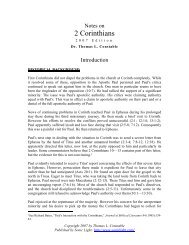1 Samuel - Odessa, Missouri Community of Christ
1 Samuel - Odessa, Missouri Community of Christ
1 Samuel - Odessa, Missouri Community of Christ
You also want an ePaper? Increase the reach of your titles
YUMPU automatically turns print PDFs into web optimized ePapers that Google loves.
92 Dr. Constable's Notes on 1 <strong>Samuel</strong> 2007 EditionSaul pursued David with 3,000 <strong>of</strong> his finest soldiers, which gave him a five-to-oneadvantage over David, who had only 600 men (23:13). The "Rocks <strong>of</strong> the Wild Goats"was evidently a local site, which archaeologists have not yet identified. There Sauldiscovered a sheepfold that evidently encircled the mouth <strong>of</strong> one <strong>of</strong> the caves in thoselimestone hills. The king entered the cave to relieve himself unaware <strong>of</strong> the mortal dangerin which he was placing himself because David and his men were hiding in the recesses<strong>of</strong> the cave.David's men interpreted Saul's vulnerable position as a divine provision whereby Davidcould free himself from his enemy (v. 4). There is no record in the text that God hadindeed told David what they said He had. He may have told David that he wouldovercome his enemy, but certainly He had not given David permission to assassinate Hisanointed, King Saul. David's advisers seem to have been resorting to pious language tourge David to follow their counsel (cf. 23:7). We must always evaluate the advice <strong>of</strong>friends in the light <strong>of</strong> God's Word even when they claim divine authority. Their counselmoved David to take some action against Saul, which he soon regretted.The hem or edge <strong>of</strong> a person's garment in the ancient Near East made a statement abouthis or her social standing. A king's hem was especially ornate and identified him as theking. 263 By cutting <strong>of</strong>f this piece <strong>of</strong> Saul's robe, which Saul may have laid aside as herelieved himself (v. 3), David suggested that he could cut <strong>of</strong>f Saul's reign just as easily(cf. v. 21). His act constituted mild rebellion against Saul's authority. 264Almost immediately David realized that his clever trick was inappropriate. Since Saulwas the king, David had no right to tamper with his clothing. Furthermore, David realizedthat any attempt to take the kingdom from Saul, as he had taken the symbol <strong>of</strong> thatkingdom, was contrary to God's will. Since Saul was God's anointed (v. 6) it was God'splace to remove him, not David's. This little incident provides another window intoDavid's thinking. David was acknowledging Yahweh's sovereignty by submitting to Hisauthority in setting Saul up as king (cf. Prov. 24:21). David refused to take revenge forthe trouble that Saul had caused him."Perhaps no greater example <strong>of</strong> wisdom practice is found than in David'sresponse to Saul." 265It is interesting that God prevented David's enemies from assassinating him later when hewas Israel's king (cf. Gal. 6:7). Compare also Jesus' refusal to take vengeance on Hisoppressors.David's verbal defense to Saul 24:8-15The object lesson that David presented to Saul had a double application. David provedthat he was not trying to kill Saul because Saul was the Lord's anointed. Furthermore heshowed that it was inappropriate for Saul to seek to kill him because he, too, was the263 See Milgrom, pp. 61-65.264 D. J. Wiseman, "Alalakh," in Archaeology and Old Testament Study, p. 128.265 Heater, "Young David . . .," p. 54. Cf. Prov. 24:21.








